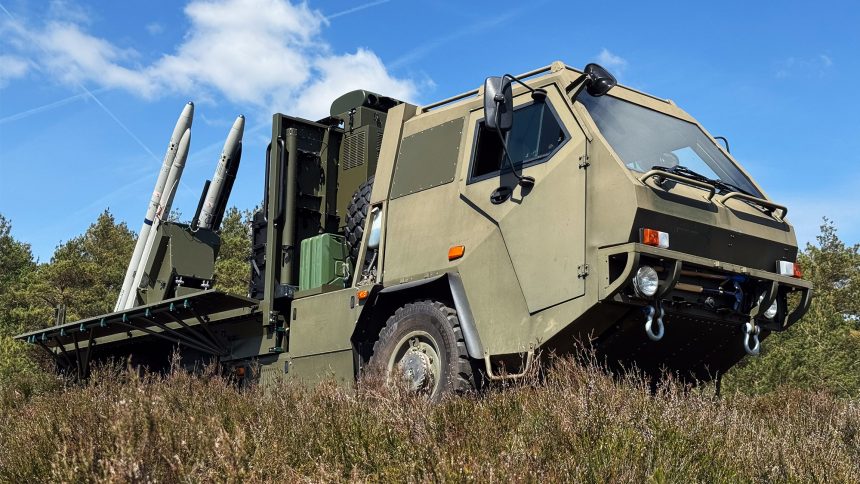Having previously broken cover in frontline videos from Ukraine, the UK-developed ASRAAM-based air defense system has now been shown off to the press and public for the first time.
Colloquially called ‘FrankenSAM’ within the armed forces, the Raven integrates a launcher system for the AIM-132 Advanced Short-Range Air to Air Missile (ASRAAM) – the UK’s answer to the AIM-9X Sidewinder – onto a Supacat High Mobility Transporter 600 all-terrain vehicle.
Raven was designed and delivered within a period of just three months using surplus missiles, widely-used vehicles, and launch rails requisitioned from retired Royal Air Force aircraft including the Tornado, Hawk, and Jaguar.
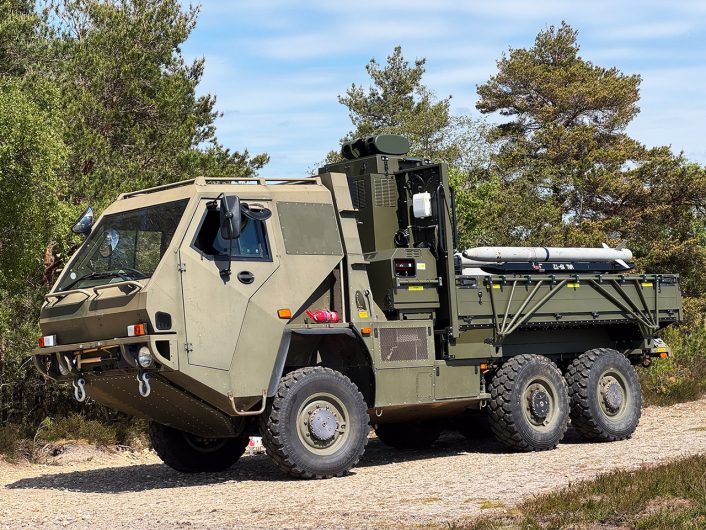
Reportedly, only three tests of the system were carried out before its first deployment to Ukraine in 2022. Since then, eight Ravens have completed over 400 combat engagements and achieved a 70% success ratio. Five more units are expected to be delivered in the near future. One vehicle was reportedly lost in 2024, according to open-source intelligence (OSINT) project Oryx.
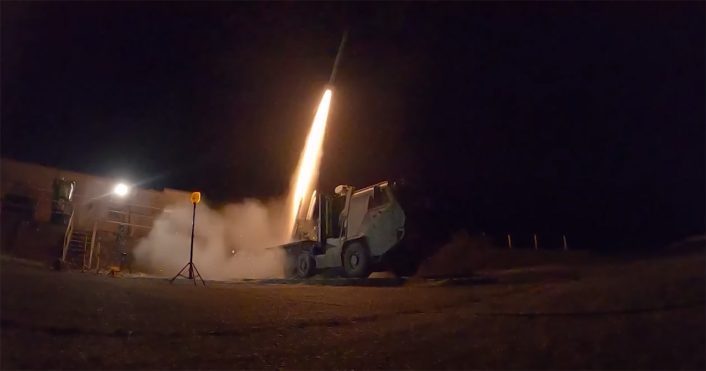
Primarily designed for short range air defense (SHORAD), the Raven’s intended targets include drones and cruise missiles, as well as helicopters and some low-flying aircraft. Target surveillance and acquisition is provided by an electro-optical turret mounted onto the vehicle. Operators can rapidly switch between this system and the ASRAAM’s integrated seeker head.
Personnel can operate the Raven from inside the vehicle, or remotely from up to 50 meters away. Remote operation means even if the launch of a missile, revealing the vehicle’s location, leads to a counterattack, the valuable crew can be protected even if the vehicle is lost.
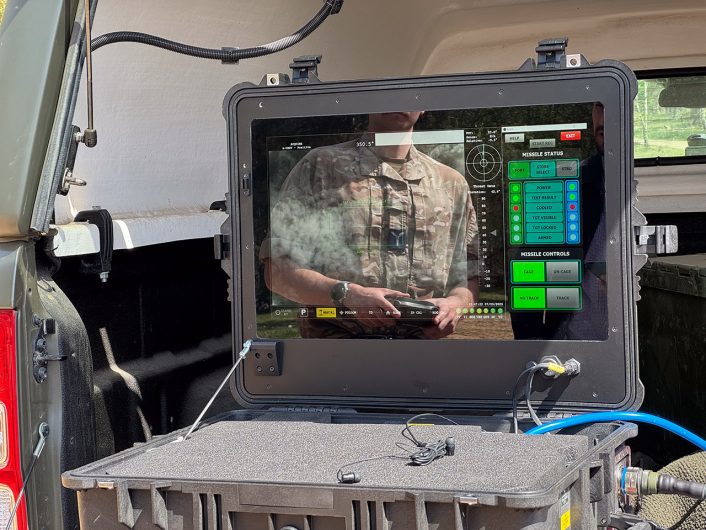
Raven is one of a number of ad-hoc systems developed by the UK and other allies for rapid deployment by Ukrainian forces. In Feb. 2025, the UK Ministry of Defence unveiled the Gravehawk surface to air missile system, which integrates Soviet-designed R-73 missiles from Ukraine’s stockpiles with a high mobility truck-mounted launcher and a similar fire and control system to the Raven.
Brimstone missiles, usually launched from aerial platforms, have been deployed using launchers adapted onto a variety of land vehicles. This surface-to-surface engagement capability has been formalized with the new Brimstone 3 variant. Surplus equipment has also been leveraged to adapt Western missiles, like the MBDA Storm Shadow, onto Soviet-designed aircraft.
It has been brought to my attention that the weapons pylon adapter for the Ukrainian Su-24 Storm Shadow has been borrowed from an out of service RAF Tornado.
Yes, there are (parts of) RAF Tornadoes launching Storm Shadow over Ukraine. https://t.co/IQCSeB8NyM
— OSINTtechnical (@Osinttechnical) July 2, 2023
AIM-132 ASRAAM
Since the retirement of their Sidewinders, ASRAAM is the Royal Air Force’s only short-range air-to-air missile, integrated onto the Eurofighter Typhoon as well as the F-35B Lightning II. It was developed with the intention of becoming a NATO-wide replacement for the AIM-9 – with the UK and Germany leading on the AIM-132 while the U.S. developed the AIM-120 AMRAAM. Politics led to splits in the program and eventually the UK was the only one left wanting the ASRAAM.
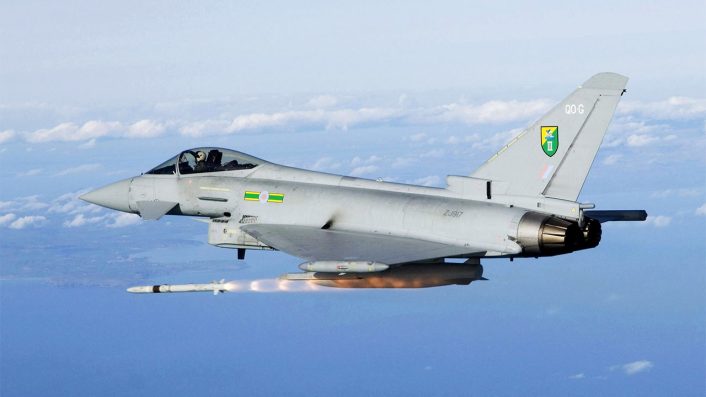
ASRAAM’s larger and more modern rocket motor and warhead designs give it a range and lethality advantage over the AIM-9X Sidewinder, although the smaller Sidewinder likely has an edge in maneuverability. Both missiles, until recently, shared a very similar imaging infrared (IIR) seeker head with a high off-boresight and lock-on after launch capability. The Block 6 upgrade replaced the seeker with a higher resolution alternative developed in the UK, which reportedly means exports of the missile are no longer bound by American ITAR restrictions.
The missile forms the basis of the Common Anti-Air Modular Missile (CAMM), a surface-to-air missile designed for deployment from ships and land vehicles. CAMM has been battle proven on the Royal Navy’s Type 23 frigates as part of the Sea Ceptor system, and will in the future be carried by the Type 26 and 31 frigates and Type 45 destroyers.
🚨 BREAKING NEWS – 🇬🇧 British frigate HMS Richmond has fired her Sea Ceptor missiles, shooting down two Houthi drones over the Red Sea. The video below shows the incident. pic.twitter.com/BBv8OQQkK8
— UK Defence Journal (@UKDefJournal) March 9, 2024
CAMM features some changes to the electrical systems as well as the integration of a datalink and the replacement of the IIR seeker with an active radar homing seeker. This makes the missile less suited for a small, mobile system like the Raven. Ground based CAMM launchers instead utilize multiple large vehicles in order to facilitate the radar, power generation facilities and the control station.
The British Army now operated the Sky Sabre/Land Ceptor air defence system, which replaced the Rapier missile in 2021.
The air defense system provides short to medium range aircraft and missile defense against saturation attacks. pic.twitter.com/kGK5tlgn3T
— Scotty (@scottyeders) April 17, 2024
Additionally, the UK’s stocks of CAMM are arguably a precious resource at the present time as up to 32 missiles are required for each of the Type 23 frigates that have been operating in high threat areas like the Red Sea. ASRAAM, meanwhile, has been in service and production longer, and a smaller stock of missiles is needed in order to fulfil the requirements of the Typhoon fleet. Surplus ASRAAMs, then, are ripe for delivery to Ukraine where they would undoubtedly be used before their rocket motors and other subsystems hit their ‘use-by’ dates.

